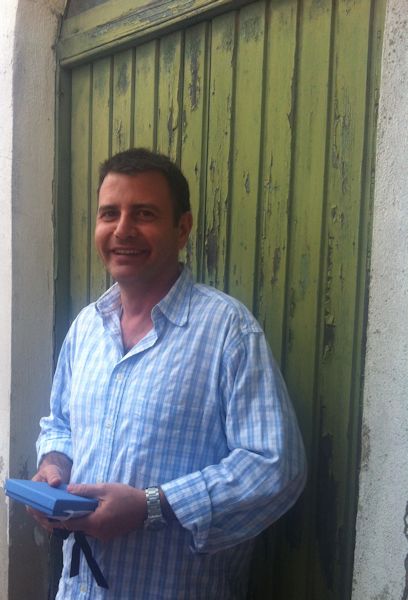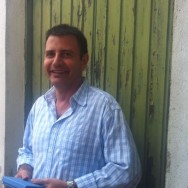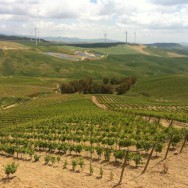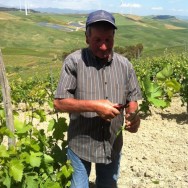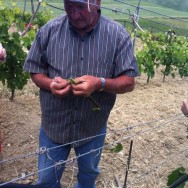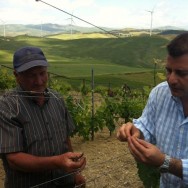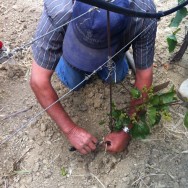Occasionally, when you visit a vineyard and a producer, in whatever troubled, busy or preoccupied state of mind you happen to be in, you are stopped in your tracks and transformed by something almost spiritual in the place and the people. So it was with Feudo Montoni and our meeting with its delightful owner, Fabio Sireci.
This was only the second time I had been to the central part of western Sicily but both times it has had a magical, spellbinding effect on me. There is a powerful feeling of peace and calmness in the air here, which perhaps comes from a sense of ancient history in the landscape itself. It reminds me of the descriptions of an older, almost forgotten Sicily, romantically depicted in the famous Sicilian novel, The Leopard.
We stood on a blustery, high point just outside the main courtyard and house of Feudo Montoni surveying the landscape before us while Fabio told us a little about the history of his vineyards.
Vineyards have existed here since the 6th century and even six centuries ago this area was an important crossroads between three ancient valleys and three provinces, Agrigento, Caltanisseta and Palermo. The area was mentioned in 1560 in “De Vinorum Historie”, the first Italian oenology book written by Andrea Bacci. The book is now owned by the legendary Antinori winemaker, Giacomo Tachis, the leading figure in modern Italian winemaking who created the ground breaking super-Tuscan wines Sassicaia and Tignanello. In this book Bacci wrote about Catania, Palermo and this area, Cammarata, whose vines were described as the size of tree trunks so they must already have been very old. The wines were described as having power, elegance and long ageing potential.
Feudo Montoni has existed in its current form since the 18th century and was founded by Fabio’s grandfather. In the last 30 years they have been making a stir with their own special clone of Nero D’Avola which has evolved over centuries without genetic mutation in a sort of splendid isolation. It has been defined by Giacomo Tachis as one of the purest clones of Nero D’Avola.
Although Fabio was modest and understated about the quality and characteristics of his special clone, he did relate to us what Giacomo Tachis had told him (although he didn’t fully understand the remark): you make a pure Nero D’Avola because you are a pure man.
There was a cold wind blowing the whole time we listened to Fabio. It’s usually cool at this altitude and this is important to offset the scorching heat of Sicilian summers. A perhaps surprising outcome of the cool temperature is the extended harvest, starting at the end of September, and continuing through all of October into November and sometimes even into December.
Fabio’s oldest vineyard is 80 years old and called Vrucara. The vines are ungrafted, bush trained and, pre-phylloxera (phylloxera arrived a little later in this more remote part of Sicily than elsewhere). It was in this vineyard that Giaccomo Tacchis discovered their special clone. What may have helped the clone to survive is that these vineyards are fairly isolated and surrounded by wheat fields rather than other vineyards. When they want to plant new vineyards, they take the scion from Vrucara and graft onto it. The roots go down very deep, up to 10 metres, and the new vines take up the nutrients. We later saw an example of this grafting by a local expert.
- Fabio Sireci
- Feudo Montoni (Vrucara vineyard to the left)
- Grafting at Feudo Montoni
- Grafting at Feudo Montoni
- Grafting at Feudo Montoni
- Grafting at Feudo Montoni
Some of our group were getting cold by now and it seemed like a good time to go inside for the tasting. Although it was a tight squeeze around the table and slightly chaotic at times we settled into a very generous in-depth tasting of the Feudo Montoni wines.
We started off with three white wines from native varieties: the 2011 and 2010 Grillo followed by the 2011 Catarratto. This latter wine was the most interesting of the whites for me with lightly aromatic, pears and spice aromas and a round, satisfyingly full texture on the palate. The flavours were characteristic Sicilian: lemon oil and salty, savouriness sliced through with a very bright, juicy acidity.
Fabio then bravely gave us a full vertical tasting of some of his older Vrucara wines starting from 1999 to 2011.
Of the older wines the best for me were 1999 and the 2003. The 1999 Feudo Montoni Contea Di Sclafani IGT Vrucara was fading a little but it had a lovely smooth, round and elegant texture with lightly grippy but integrated tannins. This was coupled with spice and intriguing hints of tar on the nose and a savoury flavour on the palate.
The 2003 Feudo Montoni Contea Di Sclafani IGT Vrucara had a distinctive, smoky meat and savoury Bovril-like bouquet with perfumed, heady notes. There was still a very grippy firm-edged tannic structure but it encased some bright, dark cherry fruit.
I found a strong resemblance to Nebbiolo on some of these wines and mentioned it as an aside to Fabio, who said that Giacomo Tachis had thought the same thing and that there may be some Nebbiolo parentage in this particular clone of Nero D’Avola. How exciting!
There was a big leap in quality in the wines from 2005 onwards, consistent with better winemaking and maybe improved vineyard techniques. Fabio said that since that vintage he had been more courageous and had used wild yeast. He had also used malolactic fermentation (MLF) on fine lees only and had stopped filtering the wines. He also added that Nero D’Avola is like a crazy horse – it needs time to be reigned in.
Below is a brief summary of my tasting notes for some of the best wines.
2005 Feudo Montoni Contea Di Sclafani IGT Vrucara – bright ruby, quite youthful core with garnet rim. Sweet, smoky, taut nose not yet fully opening. Very firm, muscular structure with firm but fine, chalky textured tannins. Nervy, firm, youthful but refined. 90
2006 Feudo Montoni Contea Di Sclafani IGT Vrucara – again a youthful ruby core, narrow garnet rim. A little smoky, tarry, meaty and heady aromas. Very modern sophisticated structure, forceful but with a refined chalky textured tannins. 92
2007 Feudo Montoni Contea Di Sclafani IGT Vrucara – dark core & youthful rim this time. Sweet dark fruits, cherries in alcohol with a little head spinning spice. Much more concentrated middle palate with dark cherries and sweet spice. Had a slightly more rustic feel to tannins but an intensity and edginess that was attractive. 93
2008 Feudo Montoni Contea Di Sclafani IGT Vrucara (served in magnum) – Bright ruby. Smoke, tar, a little fire and dried roses on the nose. It had a very smooth texture with a soft, round and satisfying middle. More complete and balanced on the palate with a creamy long finish and very refined tannins enlivened by a tangy, bright acidity. 94
One thing that stuck in my mind was that these wines were nothing like any other examples of Nero D’Avola that I had tried before in Sicily. The wines were finer, more highly strung and edgy but with more delicacy, so there is definitely something special about this clone or its terroir here in this remote part of Western Sicily.
© 2012, Susan Hulme MW. All rights reserved.

